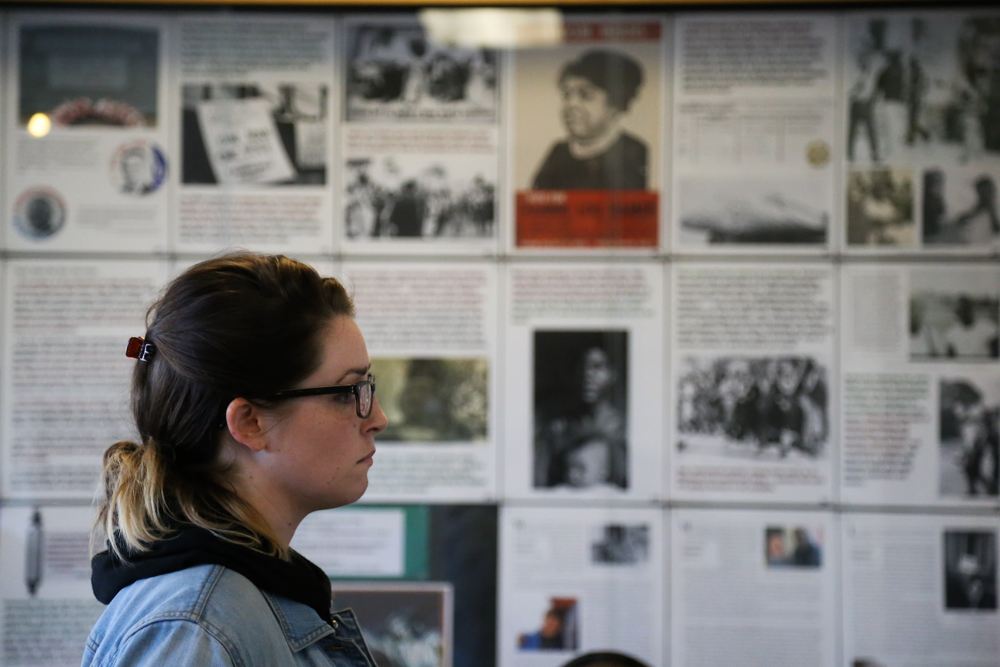Exhibit honors Mississippi Freedom Summer

By Yesica Prado
the guardsman
In the celebration of black history month, City College’s department of African American studies opened a new exhibition entitled “Mississippi Freedom Summer” on Jan. 22, which will run until Feb. 27 at Conlan Hall located 50 Phelan Ave.
The exhibition pays homage to the Mississippi summer project launched in 1964, which was a campaign founded by the Council of Federated Organizations (COFO) to attempt and register as many African American voters in Mississippi. At the time, African Americans were excluded from voting due to the intimidating voting procedure that required literacy to fill out and answer the 21 question registration form.
Although the campaign failed to register a great amount of voters, the exhibition gives a well rounded presentation of all the other projects from the Mississippi Freedom Summer that also include the Freedom Schools and Freedom Houses.
Using text and passages from the book “New Jim Crow: Mass Incarceration in the Age of Colorblindness” by author Michelle Alexander and archival photographs from Wallace Roberts, Donna Garde, Bill Steber, Mark Levy, Galen Gockel and Heather Booth, whom were all participants in the Mississippi Freedom Summer, the exhibition does an excellent job at presenting viewers with the history of this event.
However, the plain and small presentation in the two glass cases of Conlan Hall defeats the purpose of this exhibition, which is getting this unknown history to be known since using that elementary school style of presentation leaves the exhibition oblivious to our eyes.
The work consists of 41 mini posters that are composed of both text and black and white photographs, which are all arranged in a nonlinear manner. Most of these passages briefly explain the history of the Mississippi Freedom Summer, using blocks of endless text with different colors and fonts. Although the history and the parallel that exists with police brutally we face today is interesting in itself, the random arrangement of the passages, the long dense blocks of text and the variation of the size takes away from catching our attention.
The quotes are inspiring and powerful, take for example a citation from Alexander’s book which states, “the most important parallel between mass incarceration and Jim Crow is that both have served to define the meaning and significance of race in America…Slavery defined what it meant to be black (a slave), and Jim Crow defined what it meant to be black (a second-class citizen). Today mass incarceration defines the meaning of blackness in America: black people, especially black men, are criminals. That’s what it means to be black.”
Curator of this exhibition, Lawrence Bush—who is also editor of Jewish Currents magazine, carefully choose significant text to give a broad perspective of what it meant to live through this time and age. Most importantly, it also gives us a taste on what is like today, revealing that really our times have not changed much.
“Even though this was before my time, it’s still relevant because the South is still yet to change…I mean we can all relate to that I see it as in back in the 60’s when a black man can be killed just for walking down the streets that happened in that time and is still happening today. And police officers were getting off and they are getting off now, so it’s almost as nothing has changed,” said City College student Terrilyn Woodfin, whom attended the opening reception on Jan. 29.
The long trails of words endlessly continue to stretch across these two walls, screaming words of courage, sparking inspiration, telling stories of injustice, yet it leaves the viewer overwhelmed with too much information and we become lost in this ocean of past voices. It’s like being attacked by the ghost of Christmas past. It’s just too much at a time, so you are better off looking at the visuals. Because who doesn’t like a book with pretty pictures, right?
The photography used in this exhibition was in itself beautiful and captivating. Although most of these photographers were amateurs and volunteers in the program, who used their own personal cameras to capture the movement, they did an excellent job at portraying the voices of the people. In each picture, whether it is a portrait or a slice of life scene, the photographer captures deep emotion of each individual with the use of dramatic lighting and human expressions.
In Robert’s photographs, we don’t only see these emotions but we can hear the laughter of the girl playing the guitar or the gossip between the ladies sitting in the porch. We can feel the grief in the man’s voice as he plays the guitar at a memorial service for the murdered civil rights workers. We can hear the yells of the protesters as they walk down the streets of Mississippi with their signs. The photographs in itself lack aesthetics as some are too overexposed or underexposed, yet, the photographs give us the whole essence of that hot summer. There’s no need for words. Funny, I guess a picture can be worth a thousand words.
